December 13, 2013
Air Date: December 13, 2013
FULL SHOW
SEGMENTS
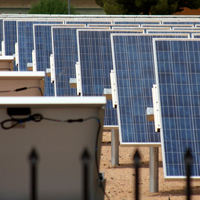
20% BY 2020 – Obama
View the page for this story
Obama: US President Barack Obama primes the renewable energy economy by leading by example. White House Environmental Executive Jon Powers tells host Steve Curwood about the President’s call for all federal agencies to get 20%of their energy from renewable sources by 2020. (02:05)
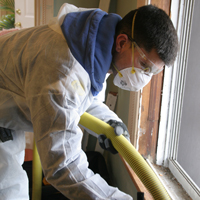
PowerShift—Massachusetts First in Energy Efficiency
View the page for this story
For the third year running, Massachusetts has won top efficiency honors from the American Council for an Energy Efficient Economy. In the next story in our series PowerShift, the state's Energy Commissioner Mark Sylvia tells host Steve Curwood what the Bay State is getting right. (06:50)
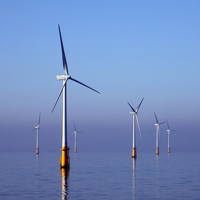
Power Shift - Cape Wind in Doubt
View the page for this story
A key federal tax credit for wind power may well expire at the end of December, throwing doubt on the future of the planned offshore Cape Wind project. Reporter Beth Daley talks with host Steve Curwood about the future of offshore wind in Massachusetts and United States. (05:40)

Beyond the Headlines
View the page for this story
In this week’s trip beyond the headlines, Peter Dykstra tells host Steve Curwood stories of some conservatives newly turned conservationists, and we remember a famous tree-sit on its anniversary. (05:10)
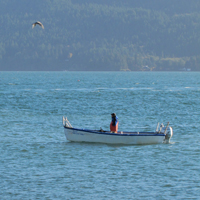
Lummi Fishing Rights
View the page for this story
In Washington state, a proposed new coal export terminal would be sited in the middle of the rich fishing grounds of a Native American tribe. But as Ashley Ahearn reports, treaty rights may give the tribe veto power over the development. (06:20)
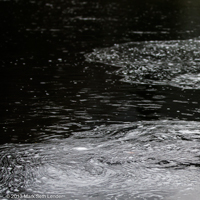
The Iconic Salmon
View the page for this story
In the Pacific Northwest, the salmon is a source of food and livelihood for people, animals and the forest. Writer Mark Seth Lender notes that this nutritious bounty for the ecosystem comes at the ultimate cost to the salmon. (03:55)
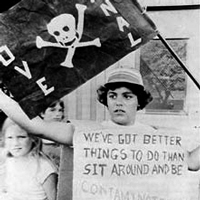
Love Canal & Lois Gibbs 35 Years Later
View the page for this story
Love Canal was a toxic dump for chemical waste used by the Hooker Chemical Company in the 1950s in Niagara Falls, New York. In the next 20 years two schools and 900 homes were built on or near Love Canal. A young housewife, Lois Gibbs, lived there, and tells host Steve Curwood that more than half the children had birth defects. She organized the community and led a precedent-setting fight against the federal government to get all the families relocated. (17:50)
Show Credits and Funders
Show Transcript
HOST: Steve Curwood
GUESTS: John Powers, Mark Sylvia, Beth Daley, Peter Dykstra, Lois Gibbs
REPORTERS: Ashley Ahearn, Mark Seth Lender
[THEME]
CURWOOD: From Public Radio International, this is Living on Earth.
[THEME]
CURWOOD: I’m Steve Curwood. President Obama sets an ambitious new goal - federal agencies will use 20 percent renewable power by 2020. Also, remembering one of America's biggest environmental horror stories.
MOTHER: Our little Julie was stillborn. The loss of our child may be a direct result to the chemicals.
ANGRY MOTHER: You are murderers. Each and every one of you in this room are murderers.
[CROWD CHANTING “WE WANT OUT”]
CURWOOD: 35 years ago Love Canal sparked a public revolt over toxic dumping.
GIBBS: We had chemicals in our house, in our air, in our backyard, in our school, everywhere. 56 percent of our children were born with birth defects; three ears, double rows of teeth, extra fingers, extra toes, and they said that they were going to do nothing.
CURWOOD: We'll have those stories and more this week on Living on Earth. Stick around.
[NEWSBREAK MUSIC: Boards Of Canada “Zoetrope” from “In A Beautiful Place Out In The Country” (Warp Records 2000)]
ANNOUNCER: Funding for Living on Earth comes from Stonyfield Farm, makers of organic yogurt, smoothies and more.
20% BY 2020 – Obama
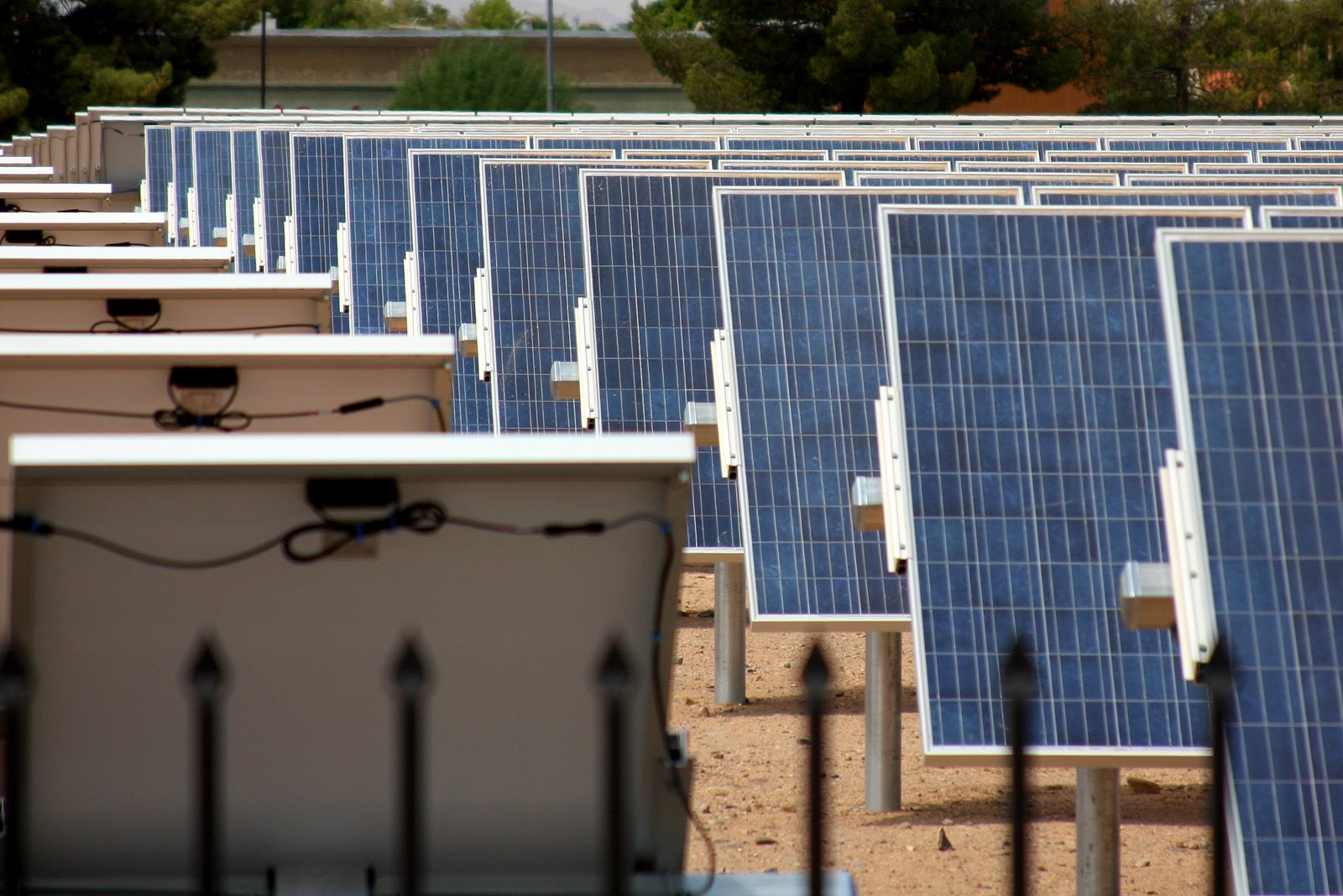
Solar array in Arizona (photo: schwnj)
CURWOOD: From the Jennifer and Ted Stanley Studios in Boston, this is Living on Earth. I’m Steve Curwood. The US government is a big customer and can boost businesses, and that’s what’s behind President Obama's executive order that requires at least 20 percent of the power federal departments use to come from renewable sources by the year 2020. John Powers of the White House says each agency can choose how it wants to comply.
POWERS: We've given the agencies the flexibility to achieve this goal in a variety of ways: to try to take advantage of onsite renewable energy projects, for instance, can they do rooftop solar, or VA hospitals, for instance, are doing really interesting work putting solar panels over their parking lots in arrays that provide shade both to the folks parking there and also provide power to the hospitals. Another option of the agencies is to contract with a local energy project that’s being developed. What this does, is that it helps that energy project get the support it needs to move forward and come online, and of course they can also go onto the market and buy green power or voluntary recs. But the intent of this is to help drive more renewable energy in this country, and we want to help agencies achieve that broader intent with their initiative.
CURWOOD: By the way, what’s the outstanding agency at this point?
POWERS: You know what? It’s hard to say. So a lot of the agencies have taken different approaches. You have EPA, the Environmental Protection Agency’s done incredible work with their renewable electricity. Then you have the Defense Department...the Defense Department is working on doing large scale, utility scale renewable energy projects on their land, some, for instance, on old landfills. But they’re committing to buy the power off of those projects.

Jon Powers, Federal Environmental Executive for the White House Council on Environmental Quality
(Photo: United States Government)
CURWOOD: Now how significant will this be in terms of savings? I’m thinking of both emissions and costs.
POWERS: Well, so, this helps towards the broader emissions goal the President’s given the federal government where we have a goal of 28 percent reduction in greenhouse gases by 2020 - and we’re on track to meet that goal. And when we meet that goal, we’ll have saved over $11 billion in energy costs.
CURWOOD: John Powers of the White House Council on Environmental Quality. Now President Obama's order to increase the federal use of renewable energy brings us to another installment in our series Power Shift, about the transition in Massachusetts to low-carbon energy.
Related links:
- Details on the President’s 20% by 2020 memorandum.
- Check out Jon Powers’ website
[POWER SHIFT THEME]
PowerShift—Massachusetts First in Energy Efficiency
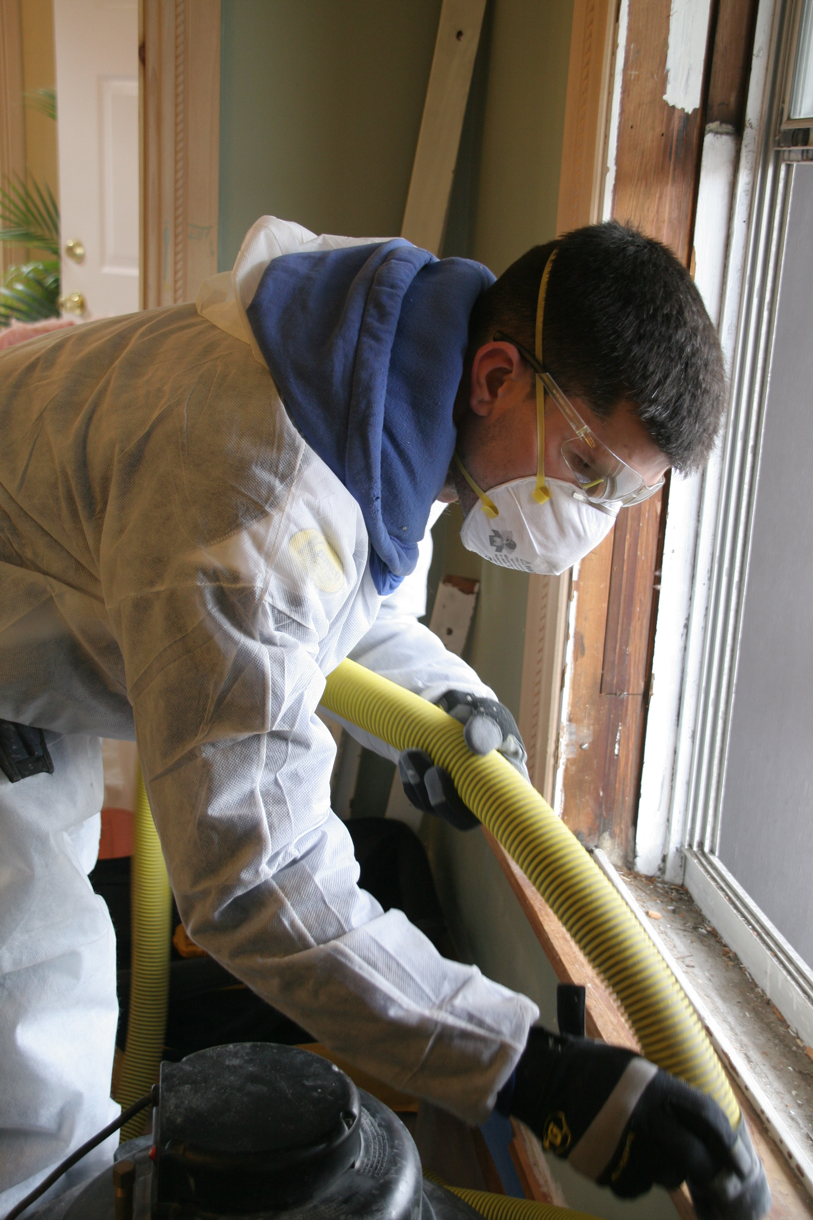
A man in Dedham insulating a home (photo: Massachusetts Department of Energy and Conservation)
CURWOOD: For the third year in a row, the Bay State has won top honors for energy efficiency. Mark Sylvia, Commissioner of the state's Department of Energy joins us to explain. Thanks for stopping by, Commissioner.
SYLVIA: Thanks, it's a pleasure to be here with you.
CURWOOD: So for the third year running, Massachusetts has topped the American Council for Energy Efficiency rankings as the most energy efficient state in the nation in America. What is Massachusetts doing to keep winning this award year after year?
SYLVIA: Well, we’re very proud of our number one ranking, and for three years in a row it is a real testament to the focus that Massachusetts places on energy efficiency. There are a number of reasons why Massachusetts has been ranked number one, most notable is our energy efficiency programs that we provide to residents and businesses.

New temperature controls help this Massachusetts YMCA save energy and money (photo: Massachusetts Department of Energy and Conservation)
CURWOOD: A lot of people attribute Massachusetts’ success to something called the Green Communities Act. Can you describe that legislation for me please?
SYLVIA: Sure. The Green Communities Act was signed into action by the governor back in 2008. It was really a landmark piece of legislation that did a number of things, one of which was to mandate that the utilities needed to provide all cost effective energy efficiency before buying additional generation to sell to their customers. That’s significant. At the same time that it placed that requirement on utilities, it really made energy efficiency our first fuel. It also required the utilities to work together to develop energy efficiency programs for all of their customers that are consistent across the state.
CURWOOD: And what about public investment? What did the state put into this?
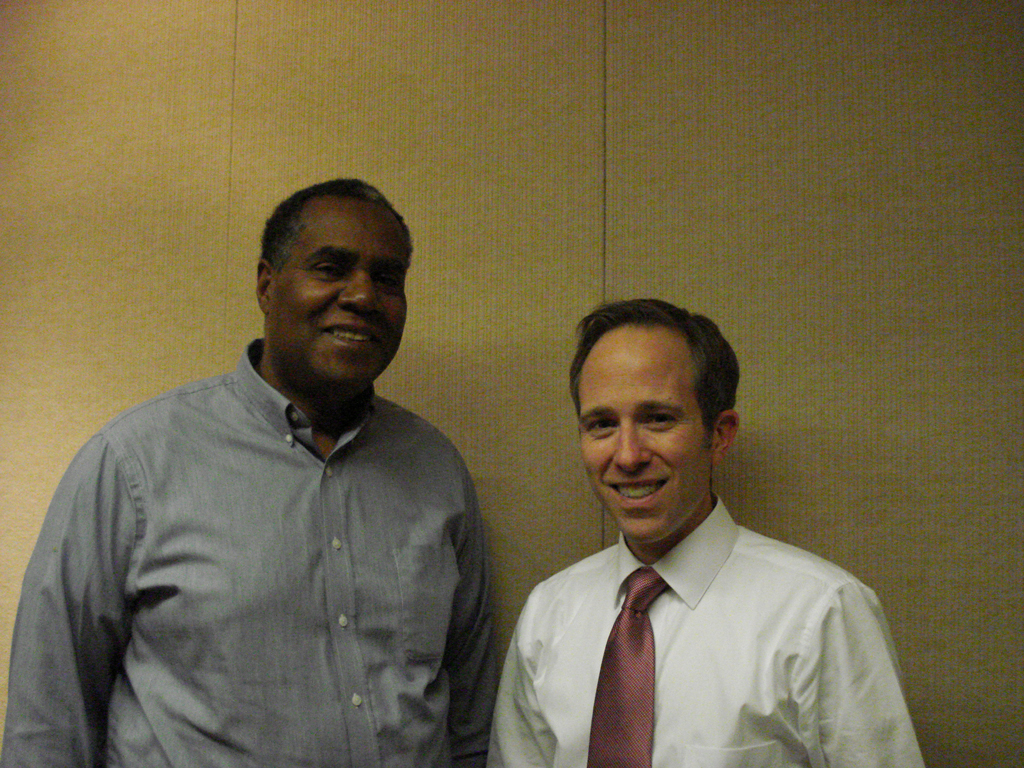
Commissioner Mark Sylvia and LOE host, Steve Curwood (photo: Helen Palmer)
SYLVIA: So, you and I as rate payers pay a systems benefit charge, so some of the funding for our efficiency programs come through what we pay in our utility bill. But in addition, Massachusetts is part of the Regional Greenhouse Gas Initiative, which is a nine-state carbon cap and trade program. And the proceeds that Massachusetts receives from participating in that program also go to fund the energy efficiency programs, so there are a number of funding sources, which is important because then that enables the resident or business to actually take advantage of the dollars that they put into the system.
CURWOOD: Quantify this for me...just how efficient is Massachusetts?
SYLVIA: Well, I mean as ACEEE has indicated, we’re the most efficient. So to give you kind of some perspective on that, from 2010 to 2012, which was the first three years of these plans that we’ve put in place, the Commonwealth invested $1.6 billion dollars towards energy efficiency, and that actually yielded $5.5 billion in benefits, or is estimated to yield $5.5 billion in benefits.
CURWOOD: What kind of benefits?
SYLVIA: Well, reduction in energy costs, also reduction in energy consumption, as well as things like jobs that have been created. So there are a number of benefits that accrue to the homeowner or businesses as a result of energy efficiency.
CURWOOD: Why is Massachusetts making energy efficiency such a high priority?
SYLVIA: So, when the governor came into office in 2007, and certainly when he campaigned for governor, one of the things that he saw that concerned him was that the northeast has very high energy costs, and the governor felt strongly that we needed to change that dynamic. And so he and his team got to work right away identifying those strategies that would help us to deal with the high cost of energy, our dependence on fossil fuels, and energy really that comes from outside of Massachusetts. We’re at the end of the energy pipeline in the northeast, we don’t have a lot of indigenous fuels that we can take advantage of, and the governor said, we need a fundamental shift in how we tackle energy issues. The Green Communities Act that you asked me about earlier was really the result of that vision. So there was the Green Communities Act, and the Global Warming Solutions Act which is another piece of landmark legislation that the governor signed, which really ultimately set the most ambitious greenhouse gas reduction goals of any state in our country.
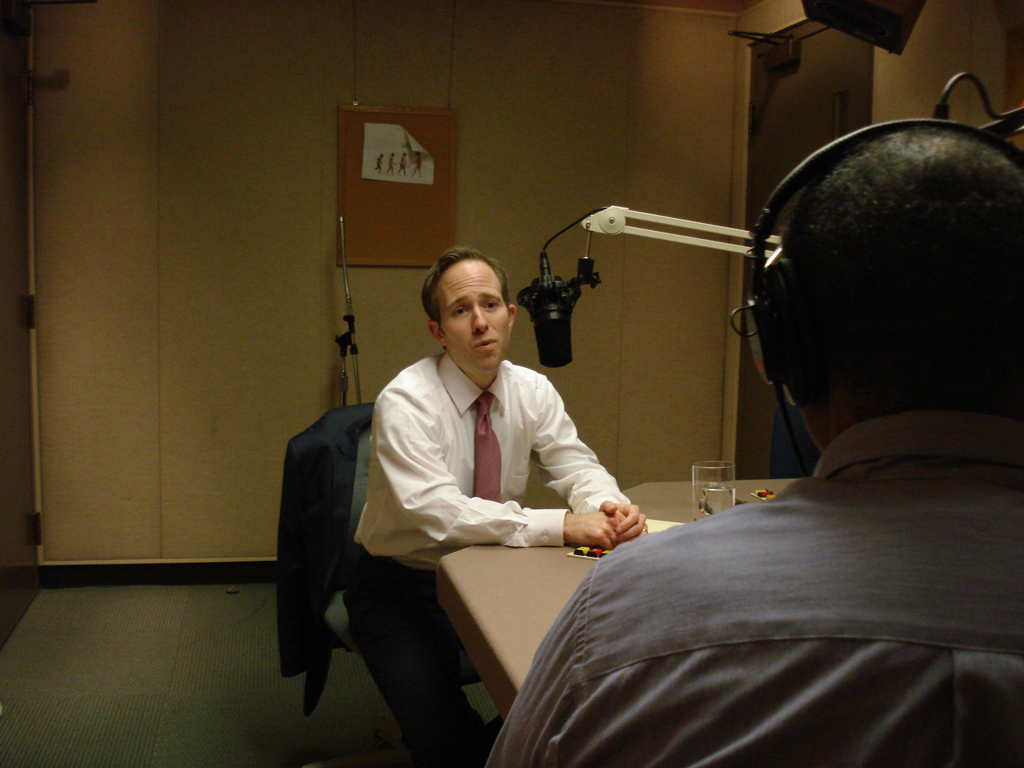
Mark Sylvia in the LOE studio (photo: Helen Palmer)
CURWOOD: So, of course, no matter how efficient you get, you still have to get electrons, you got to get electricity from some place. What about alternative energy? How’s Massachusetts doing with that?
SYLVIA: Like with energy efficiency, Massachusetts also is a leader on renewable energy. Regardless of the technology, we have a very successful renewable portfolios standard which supports the development of technologies like wind and solar. Just to give you an example on the solar front, the governor set a goal in 2007 that we install 250 megawatts of solar PV by the year 2017. Well, this year, in 2013 in May, we hit that goal four years early, and the governor said, well, we need to focus now on a new goal, and set a new goal of 1,600 megawatts by the year 2020. So solar PV has been a great success, and as you know there’s also great potential for offshore wind in Massachusetts, and all up and down the east coast, and Cape Wind is one example certainly here in Massachusetts.
CURWOOD: President Obama said that he wants to have 20 percent of the electricity that the federal government buys be renewable by the year 2020, 20 percent by 2020. How does the Massachusetts government stack up compared to that goal?
SYLVIA: So, we’re in alignment with the President’s goal. We have the renewable portfolio standard as I mentioned, so what that means is that utilities are required to have a certain percentage of their energy that they sell to their customers come from renewable energy resources. So as of 2013, that represents 8 percent in class I, so that’s a combination of wind and solar, and each year we increase that percentage by one, so next year it’ll be 9 percent, the year after that will be 10 percent, the year after that will be 11 percent, and so on and so forth.
CURWOOD: So what you’re saying is that the state is going to get the same 20 percent renewable, that is the Commonwealth of Massachusetts, buying electricity to light the statehouse or the courthouse, because overall the state’s renewable portfolio is going to be that big.
SYLVIA: Yes.
CURWOOD: Very ambitious.
SYLVIA: Well, we think it is ambitious, but it’s achievable.
CURWOOD: Mark Sylvia is the Commissioner of the state's Department of Energy. Thanks for joining us, Mark.
SYLVIA: Thank you very much. I appreciate the time.
Related links:
- Mark Sylvia’s page at the Massachusetts Department of Energy Resources
- Check out the full ACEEE rankings
Power Shift - Cape Wind in Doubt

Wind turbine onshore in Hull, Massachusetts (photo: fish cop)
CURWOOD: It is perhaps ironic that the most ambitious green energy development in Massachusetts seems dead in the water. Cape Wind is a project to erect 130 wind turbines the height of office towers smack in the middle of scenic Nantucket Sound that has faced more than a decade of opposition. Still, Cape Wind's won federal approval, but the developers are still struggling with financing, and a vital federal tax credit is stuck in the doldrums. To bring us up to date, we turn to Beth Daley, of the New England Center for Investigative Reporting who's covered Cape Wind extensively. Welcome to Living on Earth.
DALEY: Thanks for having me, Steve.

Wind turbines in the Irish Sea. The United States has yet to establish offshore wind, but countries in Europe have taken the plunge (photo: Andy Dingley)
CURWOOD: So first let’s talk about this tax credit for wind energy. What is this tax credit, and why does it feel like every year the thing comes down to the wire?
DALEY: Because it does. I mean, every year the wind industry and a heck of a lot people have tried to convince Congress that we need to keep these tax credits in perpetuity - that they shouldn’t expire every year. And the tax credits, just to remind you, basically gives a percentage back in real dollars to the project developers for developing renewable or clean energy. But Congress has been really reluctant to keep that authorized year after year, and it’s become a bit of a political football every year. The Republicans and others have said, look, these tax credits are basically just a handout to get expensive energy projects built, and we don’t think that’s the way it should go. It should be basically whatever cheap energy we can get we should go for. The Obama Administration and supporters say, well, no actually, we think that clean energy to fight climate change is critical, and what’s more, the coal and oil industry have long received similar subsidies that are maybe difficult to see, but they’re embedded basically in their business every day.
CURWOOD: Let’s look now at the offshore project in Massachusetts that’s called Cape Wind. Where are we at with that project today?
DALEY: Well, Cape Wind, for anyone who has not been around for the last 13 years in New England, came on the scene in 2001 as the nation’s first proposed offshore wind farm. It’s going to be 130 turbines in federal waters in Nantucket Sound, a very beloved place to a lot of very powerful people who did not want the turbines built. Many of them supported wind energy, but they didn’t want the turbines in Nantucket Sound. They argued it would impede navigation, impede aesthetics, and basically, Cape Wind should go somewhere else, or wait until the technology allows them to go farther offshore.
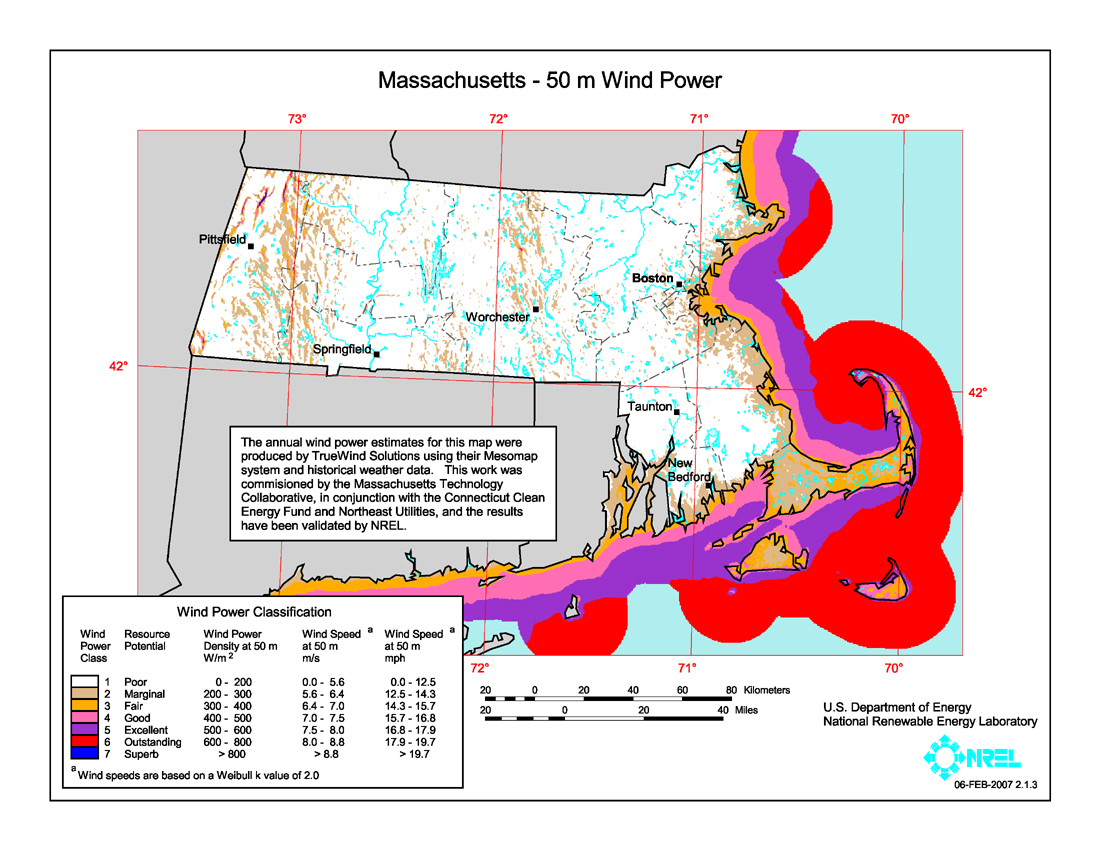
Wind turbines in the Irish Sea. The United States has yet to establish offshore wind, but countries in Europe have taken the plunge (photo: Andy Dingley)
That controversy continues to simmer, but Cape Wind after 13 years has gotten virtually every federal approval it needs to build. They sold the power, they’ve overcome lawsuit after lawsuit, although there are some still pending. But the biggest thing facing them, I think most specialists would agree right now, is the fact they need to come up with investors who want to invest in Cape Wind, and the fact of the matter is, Cape Wind is an expensive investment because while they have sold a lot of their power to utilities, it’s very expensive power.
CURWOOD: And what about the tax credit? How important is the tax credit for a project like Cape Wind?
DALEY: Cape Wind says it will go forward no matter what, tax credit or no tax credit, but specialists really say that tax credit is super super important to them. It’s hundreds of millions of dollars. That’s a lot of money to absorb by yourself.
CURWOOD: And what does Cape Wind need to do to qualify for the federal tax credit?
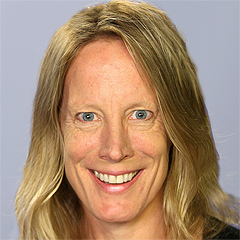
Reporter, Beth Daley (photo: Beth Daley)
DALEY: They need to start construction by the end of this year. Now, that doesn’t necessarily mean putting turbines in the water, it means have they expended enough money to satisfy the public government that they basically are starting construction. I spoke to Cape Wind recently, and they were very confident but also extraordinarily close to the vest on whether or not they would meet the criteria to get that tax credit. I pressed them and they said, well, it would be great if we get it, but we’re going to move forward anyway if we don’t. But I think from an outsider view, if they don’t get that tax credit, the project’s viability is definitely in question.
CURWOOD: So what do you see the chances are that Cape Wind makes it?
DALEY: That’s a really good question. Cape Wind is this amazing...they persevere, and it’s largely due to the developer behind it, Jim Gordon. He’s a very tenacious man who’s spent tens and tens of million of dollars if not more, working to get the nation’s first offshore wind farm in place. It’s really almost coming down to personality in some ways because it would be easy to walk away, but it’s pretty clear he’s not going anywhere.
CURWOOD: Now, when Cape Wind was first proposed, it was one of the only offshore wind projects out there in the US. What about now?
DALEY: Yes, so there’s lots and lots of offshore wind being proposed. New Jersey, there’s a project off Rhode Island, a demo project, there’s even off the coast of Martha’s Vineyard a large area that’s opening up to wind farm development. Cape Wind wants to be the nation’s first offshore wind farm, but I think there’s growing sentiment out there, I think, that as technology improves and wind farms go further offshore to escape the aesethic issue, which Cape Wind was so mired in, that people just didn’t like the way it looked and it’s a very sacred place, Nantucket Sound. The question raised is, is Cape Wind needed still in Nantucket Sound? Maybe we should build our wind farms 12 miles offshore and that will be better because no one will see it. But there still seems to be a very strong sentiment that Cape Wind really is a symbolic green step for America and a lot of people have a lot of political stake in it.
CURWOOD: Beth Daley is a reporter for the New England Center for Investigative Reporting. Thanks so much Beth for taking the time.
DALEY: No problem, thanks for having me.
Related link:
Visit Cape Wind’s website
[MUSIC: Elias Lerole “Long Trouser Kwela” from Mandela: A Long Walk To Freedom (Original Soundtrack)(Decca Records 2013)]
CURWOOD: Coming up...a different spin on the power of wind turbines. Keep listening to Living on Earth.
[CUTAWAY MUSIC: McCoy Tyner: “Contemplation” from The Real McCoy (Blue Note Records 1987) Happy Birthday McCoy 12/11/1938]
Beyond the Headlines

Some conservative Republicans are joining environmental organizations including NRDC to argue that wind turbine projects are threatening the endangered Bald Eagle (photo: Mark Seth Lender)
CURWOOD: It’s Living on Earth, I’m Steve Curwood. Time now to delve into stories from beyond the headlines with Peter Dykstra, publisher Environmental Health News and the Daily Climate.org. He's on the line now from Conyers, Georgia. Hi there, Peter.
DYKSTRA: Hi, Steve.
CURWOOD: Hey, and I understand, Peter this week you’ve got a couple of classic political contradictions to share with us.
DYKSTRA: Well, here’s one for you. We’ve got Republicans in Washington trying to protect wildlife while the Democrats are defending the issuing of permits to kill it.
CURWOOD: Hmmm, conservatives wanting to do conservation, huh?
DYKSTRA: Yes, and there’s a history of that in the Republican party if you go back far enough. Richard Nixon founded the EPA, he signed the Endangered Species Act. Teddy Roosevelt is considered the greatest environmental president of all time, and that was a century ago. But now we’re talking about eagles, and including the Bald Eagles, the national symbol, recently recovered from the endangered species list. And what’s happening is that the Obama Administration is issuing 30-year exemptions for wind farms in the event they kill eagles with wind turbines there won’t be penalties. The main ally for environmental groups in this, the Senator who’s speaking up, is a Republican named David Vitter. Environmentalists allied with a senator with a four percent lifetime score from the League of Conservation Voters. The Obama Administration had gone after wind farms that killed eagles before. There was a million dollar settlement just last month. That apparently is not going to happen anymore.
CURWOOD: So, Peter, how bad a problem is this really?
DYKSTRA: Well, nobody really has a firm number on how many eagles have died in wind turbines. There’s one study that says it may be as few as 100. It could be more than that.
CURWOOD: Now as I understand it, there’s another study that looks at the death of bats, it estimates them at 600,000 a year, so there’s still a problem with wind farms and wildlife, right?
DYKSTRA: There’s absolutely a concern. The wind industry says they’re working on it. Their supporters, mostly Democrats, are asking for regulatory relief, that’s what Republicans usually do. And then the Republicans are left protecting wildlife, that’s what Democrats normally do, and it leaves a very tight situation for the Democrats because it appears that they’re throwing eagles under the bus.
CURWOOD: Or onto the blades one might say.
DYKSTRA: There you go.
CURWOOD: Now what about this climate skeptic governor who’s made an unusual turnaround, Peter?
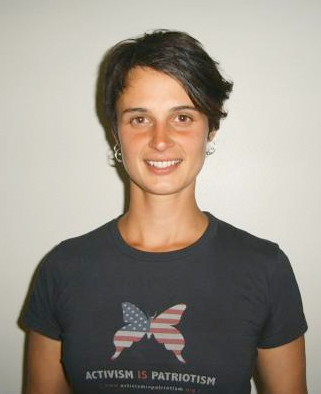
Julia Butterfly Hill in 2006 (photo: Carl-John Veraja)
DYKSTRA: Governor Paul LePage at the state of Maine, you might say, he’s a plain spoken and kind of colorful character. When he ran for office three years ago, he said that climate change was a scam, and the scam was to make people like Al Gore rich. But there’s a Charles Dickens turnaround happening with Governor LePage of Maine because he said not only that climate change was real, but climate change for the state of Maine might be awesome if it makes seaports busier and more prosperous when the Arctic melts and more ships come to call in Maine’s seaports.
CURWOOD: The holy grail of the northeast passage, huh? But I don’t think you’re working up to a Charles Dickens happy ending here.
DYKSTRA: No, I don’t think that’s in the cards. One of the problems is a standard political problem with bad timing. While the Governor was having his epiphany on climate change, there was a very iconic Maine industry that was shutting down possibly because of climate change. There’s a shrimp fleet that works the winters. It brings in small, very tasty shrimp that are shipped around the world. And that fleet has to shut down because that shrimp population has crashed, one of the reasons is that waters are getting warmer. They’re going to close it for at least a year, putting about 100 boats out of business, maybe longer than that to build the shrimp population back up.
CURWOOD: Meanwhile, Peter, is the Governor getting any backup of his rosy view of climate change?
DYKSTRA: The only backup is the snarky kind. There is a columnist for the Portland Press-Herald named Bill Nemitz, a very cynical moment in a piece he wrote last week. He got even rosier than the governor. He said the other possibilities for Maine cashing in on climate change is in the tourist trade where snowboarding could be replaced by mudboarding.
CURWOOD: OK, Peter. Take us back for a moment to the calendar in history this week, I think you have the anniversary of, well, a remarkable environmental protest.
DYKSTRA: That’s right. 14 years ago this week, Julia Butterfly Hill came down from the place she had lived for two years, and that place was 180 feet up in a redwood tree. She built a couple of platforms, lived there for two years just outside the town of Stafford, California. She named the tree Luna, and she finally came down 14 years ago this week when the logging company promised they’d spare that tree and all the trees nearby.
CURWOOD: And whatever happened to Julia and Luna?
DYKSTRA: Let’s start with Luna. Luna’s still there. There was a murder attempt on the tree, about a year after Julia came down - this was a very emotional issue in logging country - and some vandals cut that tree down. They got about halfway through it. The tree had to be saved and stabilized. It’s apparently doing OK now.
Julia Butterfly Hill is still public speaking, blogging, and getting arrested every once in a while. The town of Stafford near her protest site has had a problem with mudslides, and that may be because of the logging or may be because of the logging roads that were built.
CURWOOD: It’s hard to imagine, though, two years of your life completely devoted to a single act of civil disobedience
DYKSTRA: I guess sometimes you take a stand by sitting down.
CURWOOD: Peter, thanks so much for taking the time today.
DYKSTRA: Thanks a lot. We’ll talk to you soon.
Related links:
- Politico story about Sen. David Vitter (R-LA), eagles and wind farms.
- Living on Earth’s Earth Day 2000 interview with Julia Butterfly Hill
- More about Julia Butterfly Hill
- Peter Dykstra is the editor of The Daily Climate
- and the Environmental Health News
Lummi Fishing Rights
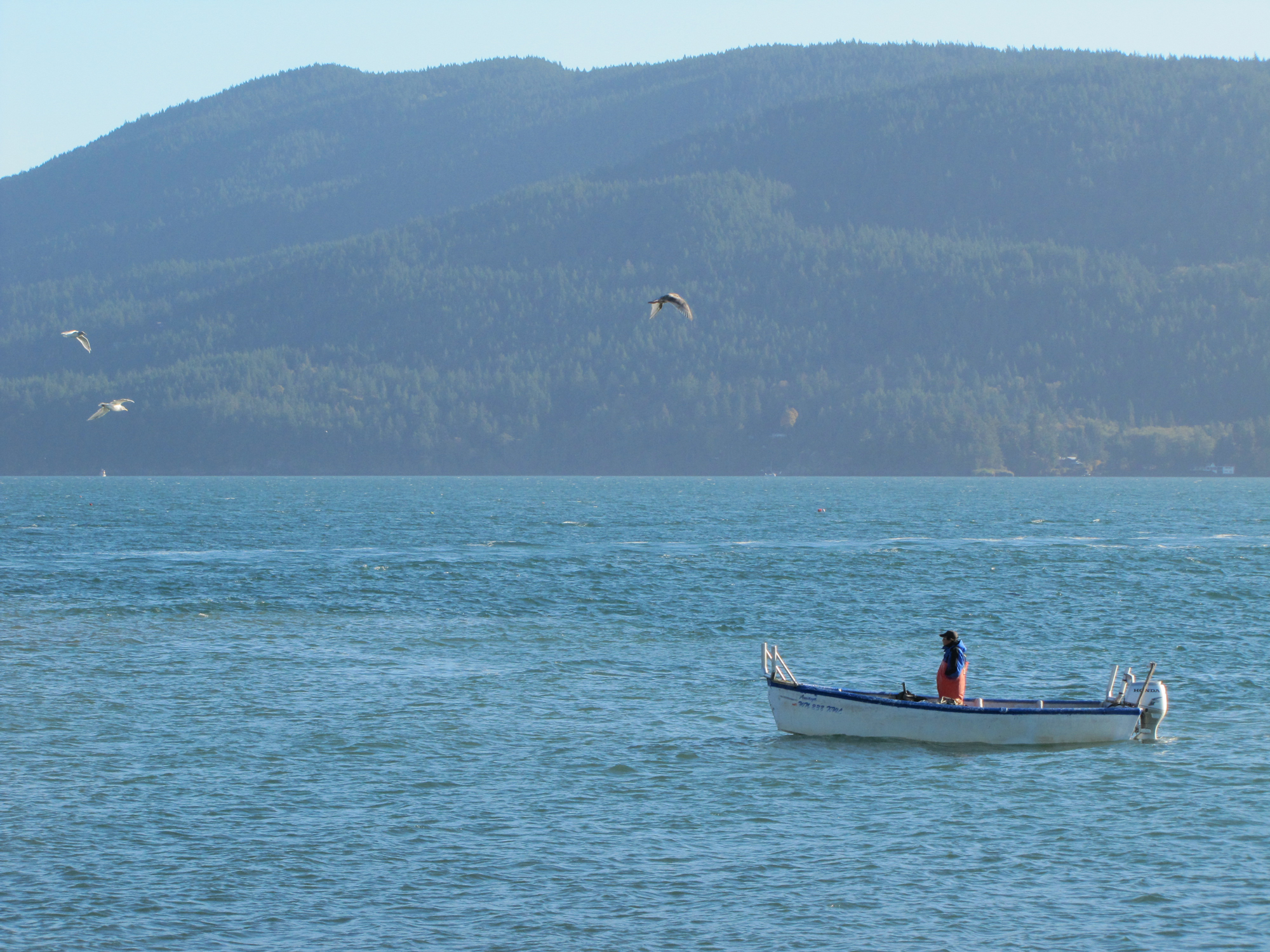
A Lummi fishing boat (photo: Ashley Ahearn)
CURWOOD: The largest coal terminal in North America could be built in northwest Washington state, at a place called Cherry Point. But the site of the possible export terminal is also a sacred place for the Lummi Tribe, whose reservation is nearby, and the waters surrounding Cherry Point are home to the Lummi's tribal fishing industry, worth millions of dollars. Thanks to a landmark legal decision affirming treaty rights in the 1970s, tribes have a say on proposed projects that could impact their fishing grounds. Ashley Ahearn from the public media collaborative EarthFix has the second part of our series, "Coal or Culture?"
[PULLING UP CRAB POT WITH LIVE CRABS]
AHEARN: Seagulls circle around the Gods Soldier, as Jay Julius and his crew pull crab pots up out of the deep blue waters near Cherry Point.
[CRABS SCUTTLING]
AHEARN: From massive buckets on deck comes the clack and rustle of delicious Dungeness crabs in futile attempts at escape.
We're just a few minutes boat ride from the Lummi Reservation, north of Bellingham.

Crabs caught by Lummi tribe members in the waters off Cherry Point, Washington (photo: Ashley Ahearn)
[SEAGULLS, MEN ON DECK]
AHEARN: Jay Julius is a member of the Lummi tribal council. His ancestors have fished these waters, just like he does now, for thousands of years.
One out of every ten Lummi tribal members has a fishing license and the Lummi tribal fishery is worth 15 million dollars annually. The tribe is worried that their shellfish, salmon and halibut fishery will be harmed by the coal dust and vessel traffic that will come with the Gateway Pacific Terminal, if it's built.
[BOAT ENGINE]
JULIUS: Now we're entering the proposed area for the coal port. You can see the buoys start.
AHEARN: Dozens upon dozens of crab pot buoys dot the waters around us, like a brightly colored obstacle course, as we approach Cherry Point. Tankers that service the nearby refinery rip up Lummi crab pots on a regular basis. If the Gateway Pacific Terminal is built it could draw more than 450 ships per year to take the coal to Asia. Those ships would travel through this area of Cherry Point.
JULIUS: What does that mean to our treaty right to fish? This will be no more.
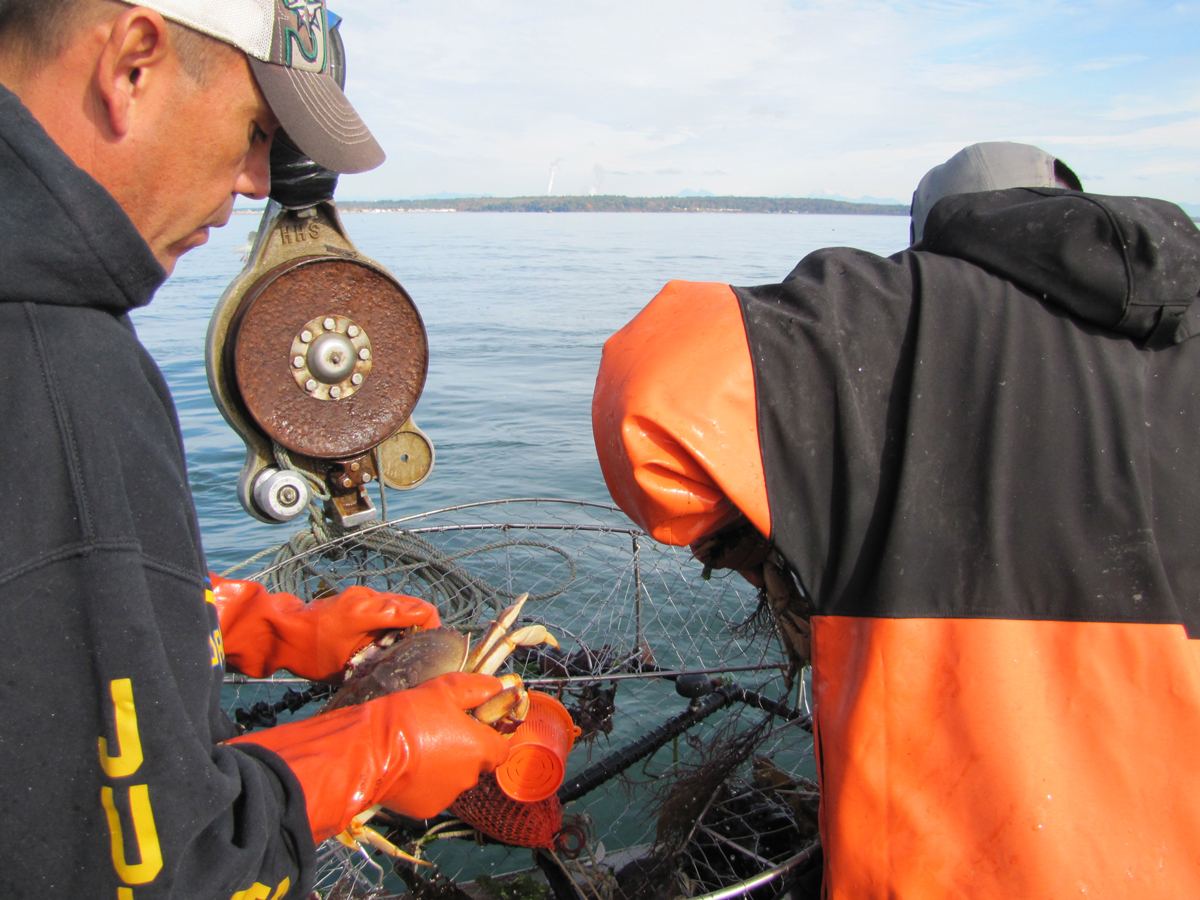
Lummi fishermen collecting crabs from traps (photo: Ashley Ahearn)
AHEARN: That 'treaty right to fish' could play a major role in the review process for the Gateway Pacific Terminal, and the two other coal terminals under consideration in the Northwest.
In the mid-1800s tribes in this region signed treaties with the federal government, ceding millions of acres of their land. Native American populations plummeted and the survivors were relegated to reservations. But the tribal leaders of the time did a very smart thing, says Tim Brewer. He's a lawyer with the Tulalip tribe.
BREWER: What they insisted on was reserving the right to continue to fish in their usual and accustomed fishing areas. Extremely important part of the treaty.
AHEARN: Those treaty rights weren't enforced in Washington until a momentous court decision in the 1970s known as the Boldt Decision. It forced the state to follow up on the treaty promise of fishing rights that were made to the tribes more than a century before.
Brewer says the phrase 'usual and accustomed fishing areas' has implications for development projects like coal terminals.
BREWER: If a project is going to impair access to a fishing ground and that impairment is significant that project cannot move forward without violating the treaty right.
AHEARN: And in recent decades tribes have flexed those treaty muscles. The Lummi stopped a fish farm that was planned for the waters off of Lummi Island in the mid 90s. The tribe argued that constructing the floating net pens would block tribal access to their usual and accustomed fishing grounds.
BREWER: And in that case the Corps of Engineers denied that permit on that basis. There was no agreement that was able to be worked out there.
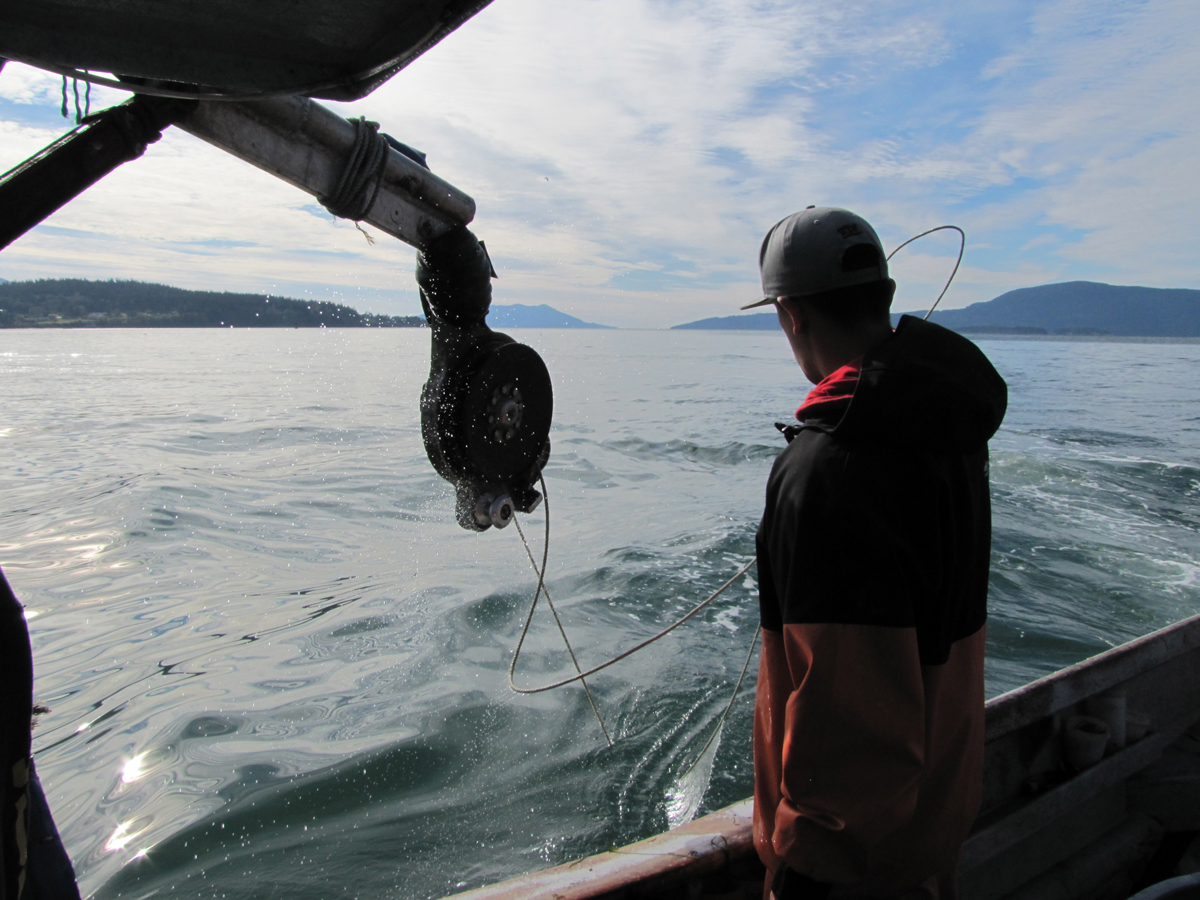
A Lummi fisherman off Cherry Point, just south of the Canadian border (photo: Ashley Ahearn)
AHEARN: But in other situations, agreements have been made.
[WALKING UP GANGPLANK]
JONES: My name's Dwight Jones. We're at Elliott Bay Marina.
AHEARN: Jones is the general manager of the marina. Behind him, hundreds of motorboats and yachts nestle into protected berths. Seattle's Space Needle pierces the downtown skyline in the distance.
JONES: Elliott Bay Marina is the largest privately owned and operated marina on the West Coast. We have 1,250 slips.
AHEARN: The Marina was built in 1991 after a decade of environmental review, and haggling with the Muckleshoot tribe. The marina is within the tribe’s treaty fishing area.
JONES: It was contentious, I guess would be the right word.
AHEARN (on tape): Could they have stopped this project from being built?
JONES: Absolutely. Oh absolutely they could have stopped it.
AHEARN: But they didn't. Instead the tribe negotiated a settlement. The owners of Elliott Bay Marina paid the Muckleshoot more than a million dollars up front. And for the next 100 years they will give the tribe 8 percent of their gross annual revenue. The Muckleshoot tribe did not respond to requests for an interview.
JONES: Anyone who's in business can tell you that 8 percent of your gross revenues is a huge number. It really affects your viability as a business.
AHEARN: (on tape): What would you say to companies that are trying to build a coal terminal?
JONES: Ha ha. I'd say good luck! It's a long road and there will be a lot of costs and chances are the tribes will probably negotiate a settlement that works well for them and it will not be cheap.
AHEARN: But will the Lummi follow the example of the Muckleshoot when it comes to the coal terminal proposed in their treaty fishing area? SSA Marine and Pacific International Terminals‚ the companies that want to build the terminal at Cherry Point‚ have lawyers and staff members working to make a deal with the Lummi to get the terminal built. From his offices at Lummi tribal headquarters, Jay Julius laughs when I ask him how he feels about SSA Marine's efforts to make inroads with the tribe.
JULIUS: I'd say they're funny, but I think they're quite disgusting, the way they're trying to infiltrate our nation, contaminate it, use people. It's nothing new.
AHEARN: SSA Marine declined repeated requests to be interviewed for this story. Julius and the Lummi tribal council wrote a letter to the Army Corps of Engineers this past summer. The Army Corps will have final say over the key permits for the coal terminal. In the letter the Lummi assert their quote: "unconditional and unequivocal" opposition to the Gateway Pacific Terminal.
The letter lays out the tribe’s reasoning behind their position, which centers around threats to treaty fishing rights and the tribe’s cultural and spiritual heritage at Cherry Point. But there's an interesting line at the end of the letter. It reads:
"These comments in no way waive any future opportunity to participate in government-to-government consultation regarding the proposed projects."
So, despite the fact that the Lummi could possess the legal power to prevent the Gateway Pacific Terminal from being built, for now anyway, the door appears to remain open for negotiation.
I'm Ashley Ahearn in Bellingham, Washington.
CURWOOD: Ashley reports for Public Media’s EarthFix.
Related link:
Check out EarthFix for more environmental stories from the Pacific Northwest
[MUSIC: Carlos Santana/Wayne Shorter “Mandela” from Carlos Santana & Wayne Shorter Live At The Montreux Jazz Festival 1988 (Montreux Sounds 2005)]
The Iconic Salmon

The essence of salmon returns to the sea (photo: Mark Seth Lender)
CURWOOD: Salmon are iconic in the Pacific Northwest, feeding people, bears, eagles - all manner of creatures and even the forest itself, when these fish return from the ocean. Earlier this fall, writer Mark Seth Lender was at Nimmo Bay in British Columbia for the end of the spawning season, to see firsthand the fundamental role of the salmon - and the price it pays.
LENDER: From the deeps of the ocean rising, skirting islands and mud bars, on into currents that twin and divide then racing the ragged coast line. Their shadows lead them, the sun behind, each one single-minded, they swim without respite, toward one place only: the one they must find.
Entering a wide bay blessed by many rivers they press against the outflowing of the tide. They seek by taste (as water blends brackish to sweet) and by the way the river courses, each bend a marker, every rock a signature and a sign post. By length of day, between boulders and through rapids they find their way. Led by Magnetic North clear and simple as a map inked by hand. Driven. Onward. Laddering falls, landslides made of water. Upstream. Always. Salmon returning to the places they were born.

A Lummi fisherman off Cherry Point, just south of the Canadian border (photo: Ashley Ahearn)
Salmon remembers. Every pool, its light, the depth, the way the eddies flow. The texture, how ripples bounce between the shores, crossing and re-crossing, a vibration felt in the thin line scribed along their sides. Each pattern is unique. A moiré for all the senses. Even the odor - cedar and spruce and the indefinable sweetness from the peat of the forest floor is known. And all this Salmon owns.

A salmon after spawning (photo: Mark Seth Lender)
Orca will harry them. Seal and Sea Lion greet them one by one in a tooth-filled underwater grin. Some will weaken, tangle in the kelp and drown there as even a fish without strength to swim will drown. On the rise of the rain-fed stream, by flood tide and ebb tide, by water piled high by wind some will break free… and be on their final way. Others will be stranded. They will struggle and flail so that crows and eagles will find them, and curious at the mystery of their return with beak and talon divine their entrails, and cast their bones. Grizzly bear and black bear will find them leaping. Timber Wolf will play them as they climb. Great paws deft as an angler’s lure; great maw sure as a net of unbreakable twine.
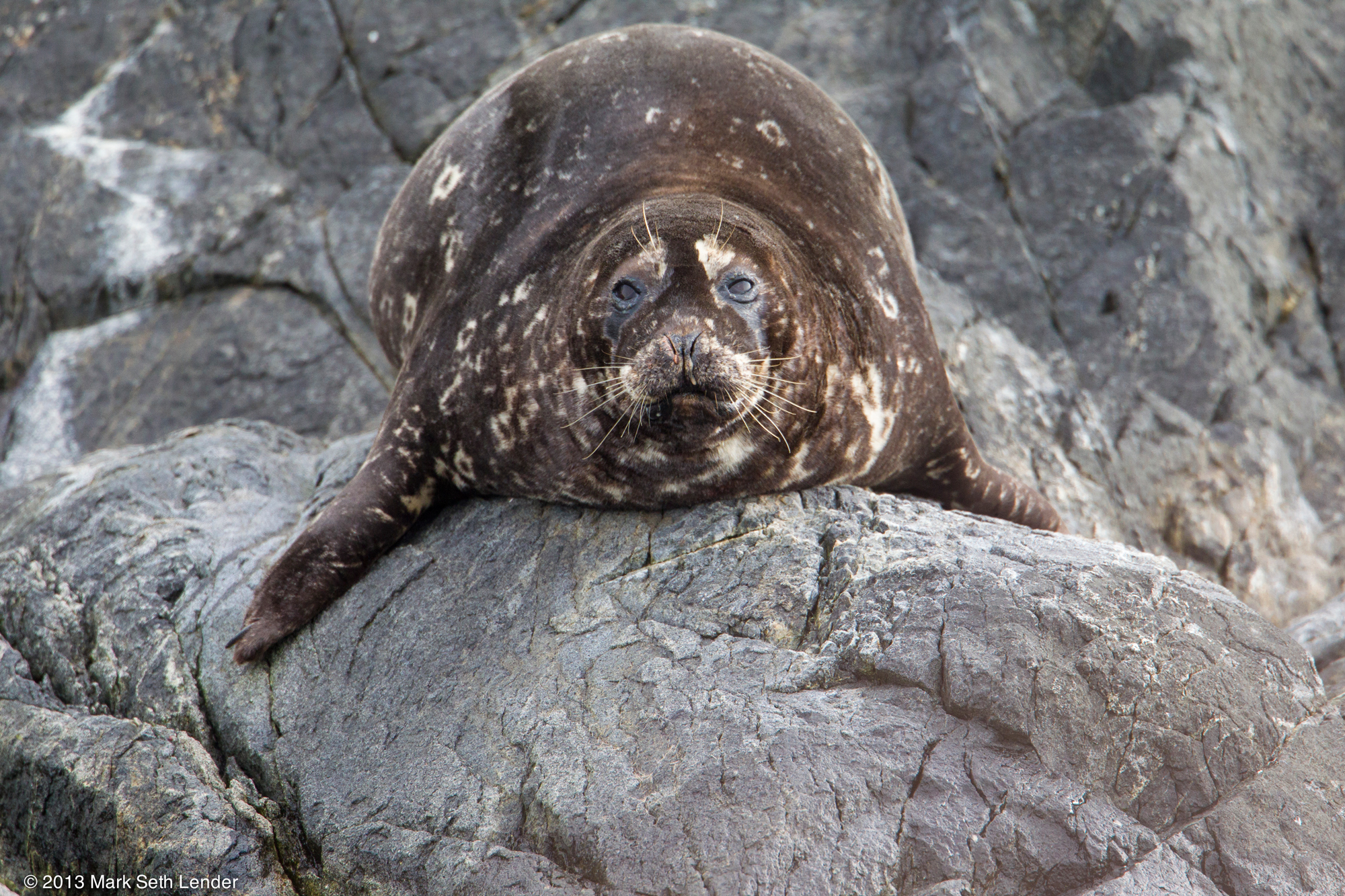
A seal fat on salmon (photo: Mark Seth Lender)
Some survive, their milt and roe commingling, the seed of generations that will follow them. Having found what they came for, now begins the great unraveling.

A kelp forest along the salmon migration route (photo: Mark Seth Lender)
On the emptying of the tide clots of thick white foam float down and where the river joins the bay meld onto the surface, churning and turning in the flow. Having fed along the way all the great ones of ocean and of stream, of forest and of air, all their promises fulfilled, the final essence of salmon returns to the sea.
CURWOOD: There are some of Mark Seth Lender’s photographs at our website, LOE.org.
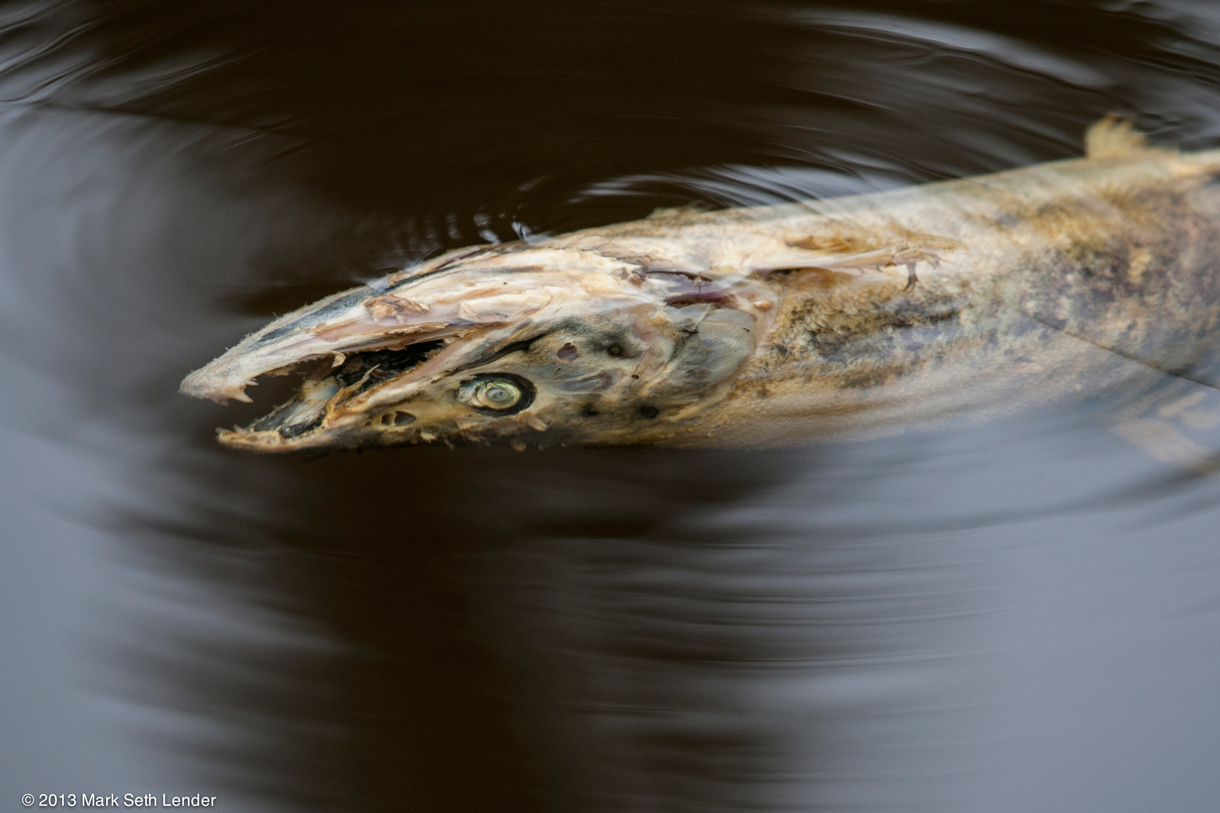
Shortly after spawning up river, salmon die (photo: Mark Seth Lender)
Related links:
- Nimmo Bay Wilderness Resort
- Thanks to Sabrine and Vancouver’s Metropolitan Hotel
- Check out more of Mark Seth Lender’s photos and essays
[MUSIC: Gill Scott Heron “Rivers Of My Fathers” from Winter In America (TVT Records 1971) For my Brother Bobby Jackson…..You will be missed]
CURWOOD: Coming up...remembering an iconic environmental battle, Love Canal, 35 years on. That’s just ahead on Living on Earth. Stay tuned.
[CUTAWAY MUSIC: Abdullah Ibrahim: “Mannenberg Is Where It’s Happening” from Voice Of Africa (Kaz Records 1988) In Memory of Madiba Nelson Mandela (07/18/1918 – 12/05/2013)]
ANNOUNCER: Funding for Living on Earth comes from the Grantham Foundation for the protection of the environment. Supporting strategic communications and collaboration in solving the world’s most pressing environmental problems. The Kendeda Fund, furthering the values that contribute to a healthy planet, and Gilman Ordway for coverage of conservation and environmental change. This is PRI, Public Radio International.
Love Canal & Lois Gibbs 35 Years Later
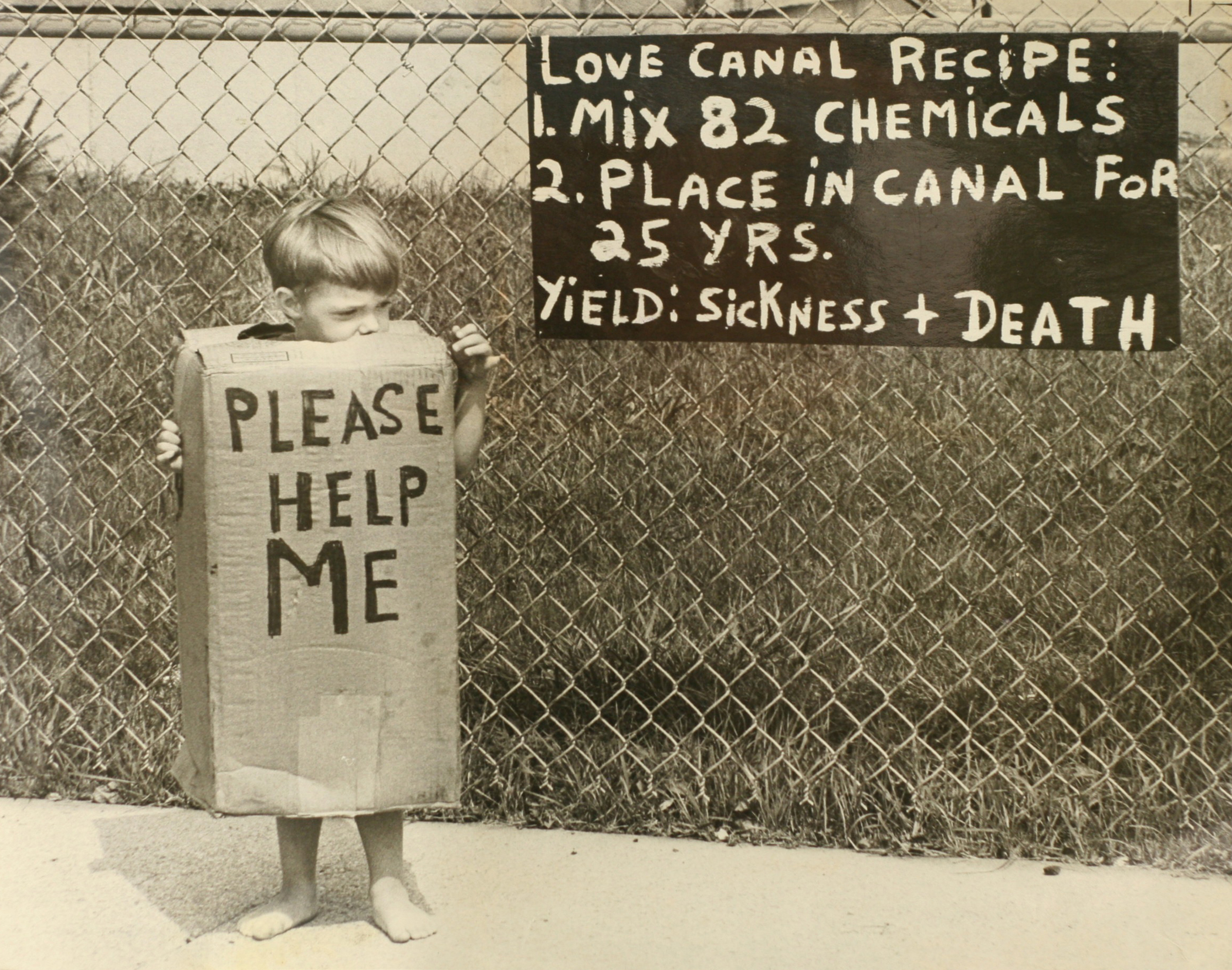
Children and babies were the most at risk for health effects from chemical exposure. (Fierce Green Fire)
CURWOOD: It's Living on Earth, I'm Steve Curwood. 35 years ago, a charmingly named community in Niagara Falls, New York became synonymous with environmental disaster.
Love Canal was a 36-block neighborhood built directly on top of 21,000 ton of toxic waste dumped there by Hooker Chemical company. Two schools were built on the site, and families experienced the effects of this toxic stew first, and they started to hold angry meetings.
MOTHER1: I carried the child for 9 months. The baby weighed three pounds and it was a stillborn birth.

Young residents in Love Canal joined the protest. (Center for Health, Environment & Justice)
MOTHER2: Our little Julie was stillborn. The loss of our child may be a direct result to the chemicals. Please don’t let this happen to anyone else before you get them out. Don’t let it happen to yourselves.
ANGRY MOTHER: You are murderers. Each and every one of you in this room are murderers.
[CROWD CHANTING “WE WANT OUT”]
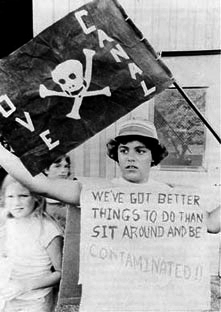
A love canal resident protesting in 1978. (Wikipedia Common)
CURWOOD: They all wanted to get out, and they wanted answers. One of the principal organizers was a young housewife named Lois Gibbs. As head of the Love Canal Homeowners' Association, she researched the history of the toxic dump, rallied the protests and demanded state and federal action. At one point in 1978 when EPA officials visited the community, Lois Gibbs led the activists that refused to let the officials leave until the federal government promised to relocate the families.
GIBBS: Just pass the word around...nobody...we're not going to do anything violent, we're just going to keep them in the house nothing more than that. Body barricade the doors. OK? OK, pass the word. And don't let 'em out. C'mon guys, sit! If I was to let the two EPA representatives come out this door, does anybody know what would happen to them?

The 93rd Street School where Lois Gibb’s son was asked to attend kindergarten. (Environmental Protection Agency)
[CHEERS, JEERS]
MAN FROM EPA: I guess I'm here for the duration.
REPORTER: Meaning what - for the duration?
EPA: Well, I guess until the White House gives the homeowners some sort of answer.
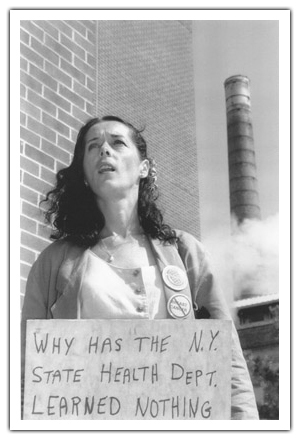
The community of Love Canal is infamously the site of one of the greatest environmental battles in the US/ (Environmental Protection Agency)
CURWOOD: President Jimmy Carter did finally declare a public health emergency, and ordered the residents relocated and called for federal funds to clean the site up.
CARTER: The whole question of the disposal of hazardous waste, especially toxic chemicals, is going to be one of the great environmental challenges of the 1980s. There must never be, in our country, another Love Canal. Thank you very much.

Lois Gibbs was the president of the Love Canal Homeowners Association in 1978 and led the demand for residents to be evacuated from the community by the federal government. (US Department of Justice)
[APPLAUSE]
CURWOOD: That audio comes to us from the documentary film A Fierce Green Fire.
35 years on, much of Love Canal is abandoned, but the battle helped launch CERCLA, the Comprehensive Environmental Response Compensation and Liability Act, better known as the SuperFund Act. And it launched the environmental career of Lois Gibbs, who came by the studio recently to recall how she felt when she started to understand what was going on in her neighborhood.
GIBBS: Well, at first I didn't do anything but cry because that’s usually what you do when you don’t know what to do, and then I got angry because I went to the school board and said, “move my child from the school, it’s on a dump, he’s sick”. And the school board said, “if we move Michael Gibbs from the school, we have to move all 407 children, we’re not about to do that because of one irate hysterical housewife”. And I’m thinking, like, it’s alright to be irate and hysterical when someone’s holding a gun to your child’s head. We had chemicals in our house, in our air, in our backyard, in our school. Everywhere. And they said that they were going to do nothing! So I began by putting together a petition to circulate around the neighborhood to close the school. You wouldn’t think that you’d need to do that hen you have a school on a dump and children are sick, that someone might come close the school and move the children, but it didn’t happen.

In a phone call from federal officials in Washington Lois Gibbs learned that all of the Love Canal residents would be evacuated. (US Department of Justice)
CURWOOD: By the way, what were the chemicals that were in there that you found out about?
GIBBS: Some of them were chemical warfare products that they were making back in the 40s and 50s, parts of the Manhattan Project was there, so you had radioactive waste, and then you had over 200 chemicals that came from the chemical factories in downtown Niagara Falls which were pesticides, solvents, things like you find in the gasoline stations, I mean it was just nasty stuff. And some of those chemicals actually came up to the surface because Mother Earth is a very special thing and she keeps pushing out these bad things, and so we had lindane, which is a pesticide that’s been banned in this country since the 70s, on the surface, 100 percent pure. And this is on the surface of the playground where my child and 800 other families’ children played every single day.
CURWOOD: So you started circulating a petition to close the school down, and what happened then?
GIBBS: Well then the state came in, the state of New York came in, and did some testing and they found the houses had chemicals that were above a workplace standard, so that’s for an adult male, 140 pounds, 40 hours a week, and based on that and based on some house studies they did, they determined that it was safer to move pregnant women and children under two. So this was August of 1978. And we just stunned. Our children, our babies, are canaries in the mine, and to remove the canaries does not remove the poisoning, and does not protect the children. So we became very angry, because we realized, if that’s what they felt, then it had to be a whole lot worse. And so we began organizing, and we got people involved, and we did our own house study, and it was amazing. We found 56 percent of our children were born with birth defects. 56 percent with three ears, double rows of teeth, extra fingers, extra toes, mentally retarded, It was just awful. House after house after house would just tell us these horrible diseases, and when we presented it to the state health department and said, “look what we found”, they said it was useless housewife data collected by people with a vested interest in the outcome. And I’m always amazed because - now I’ve been doing this for 35 years - an industry releases a report, BP, Exxon, whatever industry, their reports are always scientifically valid, and almost gospel if you will, and ours is just “useless housewife data”. How come they don’t have a vested interest when BP’s looking at the oil spill? Nobody said anything like that to them. And so I got angry again because now it became a matter of life and death and principle. And so we forced them to do their own study, and guess what, they found exactly the same thing. In fact, the gentleman came up to me and said, “You’ll be so surprised, Lois. We found the same thing you found.” And it was like, what did you think, we were making it up? I mean, my goodness! And when they found that, then they agreed to move entire families in the first two rows of homes - that’s 239 families - and pregnant women and children under two in the outer community.
CURWOOD: This is the fall of 1978, and it’s time for kids to go back to school.
GIBBS: Well, except for they couldn’t go to that school, we did close that school and not only did we close that school, we closed the second school which was at the northern end of our community, 93rd Street School, and our children were bussed to another school. So imagine for a moment, that you’re told not to go in your basement, you’re told not to go in your yard, you’re told not to plant a garden, and you’re told that none of your children can go to school in the neighborhood because it’s unsafe, but somehow it’s perfectly safe for you to live there, and bring those children home every evening after school? It’s just insane. So we continued to organize, we continued to fight back, by May of 1980 we won relocation of all families who wished to leave temporarily, and then October of 1980 President Carter signed an appropriation bill that allowed all 900 families to leave.
CURWOOD: At one point, some of the folks that were organizing with you held some EPA officials - some say kidnapped them, hostage against their will?
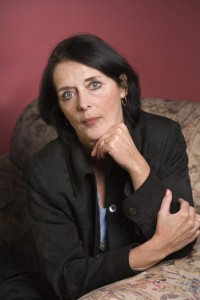
Lois Gibbs founded the Center for Health, Environment & Justice after her experience at Love Canal. (Center for Health, Environment & Justice)
GIBBS: [LAUGHS] Yes, I say we detained them for their own protection! This is in May of 1980. That’s actually what got us the relocation. EPA had come down and told us all the things we couldn’t do, which I just mentioned, and then said we had chromosome breakage, and chromosome breakage means that we have a higher risk of cancer, birth defects, and miscarriages. But the thing that really broke the...sort of the straw that broke the camel’s back was when they said it’s not just about the adults in the community, these chromosome breakages could be in your children, and people just panicked. And they all came to this front lawn of the abandoned house where we had our offices, and they’re all looking at me, it’s like, “Lois, what are we going to do?” and I’m thinking like, “My goodness, I’m going to be a target here because people are so angry.” So I called the EPA representatives to the house to explain to the larger group, what does this mean? And when they got there, people said, “you know what? If it’s so darn safe for us, it can be safe for you. And we’re going to hold you in this house until President Carter does the right thing”.
So they were in the house and 500 people literally encircled the house and sat down, so they couldn’t get out. But after a while, it got really rowdy out there, people were feeding off of one another and they were getting angry. The FBI said they were going to come in and they were going to take the hostages from us if we don’t let them go. So we gave the White House...we let them go, kept them for five hours, and we let them go and gave the White House an ultimatum. They had until Wednesday at noon to evacuate us, or the hostage holding as it was coined, would look like a Sesame Street picnic to what we would do Wednesday at noon. We had no plan for Wednesday at noon! We had no clue what was going to happen Wednesday at noon, but I didn’t go to jail, and in fact, one of my hostages sent me a telegram - which young people today may not know that is - but sent me a telegram that said, “I hope you win everything you guys are fighting for. Thank you for the oatmeal cookies. Your happy hostage, Frank.” And what he knew and I didn’t know was that the telegram was going to be - if I went to jail - would be used to say he wasn’t harmed at all or stressed in some sort of way. So I was very thankful to Frank.
CURWOOD: So President Carter issues the order, all families are evacuated. Where do you go?
GIBBS: Well, I moved to Virginia to buy a house there, and set up a new organization to meet the needs of people just like me, the Center for Health Environment and Justice, and I did that because hundreds of people called me and said, “I think I have one of those.” Woburn, Massachusetts, people in North Carolina, people in Texas who were telling me they had these children that were born without their brains, or their brains were born outside of their skull, I mean, it was scary stuff, and I said, there’s a lot of really extraordinary environmental groups out there, but none of them were prepared to deal with communities. They could deal with squirrels and bugs and birds and flowers and trees, but had no clue what to do with people. And so we set up the Center for Health Environment and Justice in order to help other people.
CURWOOD: So you had a victory in getting folks evacuated from Love Canal, but this must have come at a fairly high cost to yourself.
GIBBS: It did. I had to move to DC which is away from my family. I’m a very family oriented person. My husband and I ended up getting divorced. He was a chemical operator and a chemical worker, he was incredibly supportive, but after Love Canal he wanted me to come back home and be a full-time homemaker again, and I just couldn’t do that.
CURWOOD: So you were very successful with assertive community organizing, demonstrations and all that. That’s so 70s!
GIBBS: We need to go back to the 70s! In today’s world, everybody’s so afraid to take risks. It’s like, c’mon guys, what possibly could go wrong, especially when you’re 23, you can make a couple of mistakes and it would be OK. The way that politicians react is when there is public voices saying, we want you to behave differently. We’ve seen this...you look at Governor Cuomo. Governor Cuomo wants to frack all of New York. He would love to frack tomorrow, but there are huge voices across the state of New York saying, no, you can’t do this to our water, you can’t do this to our land, you can’t do this to our food. That is how we win.
CURWOOD: What are your largest concerns about human health and chemical exposure these days?
GIBBS: You know, I’m really frightened. All the science that is coming out is really talking about us being pre-polluted, that is the term they often use, but the chemicals that my mother had transferred to me, the chemicals that I had transferred to my daughter, and she has two grandchildren....I have two grandchildren, she has two children. And so her chemicals transferred to her children, and our bodies are just so contaminated now, and when you look at some of the increase in disease, and you’re saying, “oh my goodness how do we turn some of this back?” So for example, vinyl flooring. There was just a study that came out about vinyl flooring and asthma. Vinyl flooring off-gasses, it evaporates chemicals into the air. And they’re talking about potentially it being associated with autism. Sort of makes sense when you think about a small child that’s laying on a blanket on the floor, a vinyl floor, and then that child is crawling around on that vinyl floor, putting his or her fingers in her mouth, and just collecting all these chemicals into their bodies, and that’s very frightening. It’s like, we have to stop doing that. And we have to at least let the consumers know, what’s in the product. Right now there are 80,000 chemicals on the market, and we have little clue about what chemicals cause what disease. I’m sure there are a lot of very safe chemicals there, but I couldn’t tell you that, nor can the Environmental Protection Agency, or the Food and Drug Administration.
CURWOOD: You say the government couldn’t tell as about it? Why?
GIBBS: Because they’ve never tested them. You know a lot people know about asbestos - it’s been taken out of our schools, out of our buildings, when you buy a home, someone’s always checking for asbestos. You know, asbestos, they tried to get it banned in this country and the chemical industry stopped it. Now how could do you do that? We know about asbestos. We know it causes lung cancer. My goodness, they can’t stop it, they don’t have the tools in the toolbox to stop it. And now there is some conversation about a reform, a chemical policy reform bill on the Hill, and what would that look like? And the reason that bill is on the Hill I might add, is because of the wonderful fabulous work of community groups across this country. So in Washington State, there are a bunch of chemicals that cannot be in products in that state. California just passed a fire retardant law for mattresses and different sort of furniture. Maine has passed a number of laws. Michigan’s passed laws. Massachusetts passed laws. And so here you have all these states that are saying the federal government isn’t going to protect our citizens, we’ll protect them. And so the industry’s going a bit crazy saying, “if I have a mattress, I can sell this one here and that one there, and it’s just too hard”. And when this gentleman told me this, I’m like “well, I have an idea, why don’t you make them all safe and then it won’t be a problem?” It’s kind of a no brainer here. But it’s true; so as a result of all this groundwork being done, there’s now industry coming to the table at the national level saying, “OK we need chemical policy reform, we need labeling, we need banning, but we don’t want to ban as many as you do”. And I keep saying, “let’s keep passing those bills at the local level, at the state level, and keep the heat on the industry”.
CURWOOD: So in 1978 you spoke up at first really to protect your own child and of course it grew from there. And so your child’s all grown up now. How did it turn out?
GIBBS: My daughter almost died of a rare blood disease, but she did recover from that. Michael is healthy. Melissa, as I said, gave me two beautiful grandchildren who are perfectly healthy, and I’ve had two children since Love Canal, and so it turned out well I think. We were lucky or blessed to be able to survive that.
CURWOOD: We’re stepping into the season of gratitude and gift giving and all that sort of thing. What are you grateful for, Lois Gibbs, after telling America about Love Canal?
GIBBS: I think what I’m grateful for is I have my health and my children’s health, and that over the last 35 years, we’ve made a difference. We really have made a difference. We’ve passed laws, we’ve helped people. I mean, I go to bed at night and say, if I was to pass this evening, I wouldn’t regret anything, that’s a really good place to be.
CURWOOD: Well, I want to thank you for coming by. Lois Gibbs, who 35 years ago, started the protest at Love Canal. Thank you so much.
GIBBS: Thank you so much for having me. This was great!
Related links:
- Center for Health, Environment & Justice
- A Fierce Green Fire
[MUSIC: Love Canal – Gibbs: Bill evans/Jim Hall “Dream Gypsy” from Undercurrent (Blue Note Records 1988 Reissue) Last week we celebrated Jim’s Birthday, this week his passing 12/4/1930 – 12/10/2013)]
CURWOOD: Living on Earth is produced by the World Media Foundation. Naomi Arenberg, Bobby Bascomb, Emmett Fitzgerald, Helen Palmer, Kathryn Rodway, Adelaide Chen, James Curwood, Jennifer Marquis and Gabriela Romanow all help to make our show. Jeff Turton is our technical director. Alison Lirish Dean composed our themes. You can find us anytime at LOE.org, and like us on our Facebook page - it’s PRI’s Living on Earth. And we tweet from @LivingOnEarth. I'm Steve Curwood. Thanks for listening.
ANNOUNCER 1: Funding for Living on Earth comes from the Grantham Foundation for the protection of the environment. Supporting strategic communications and collaboration in solving the world’s most pressing environmental problems. The Kendeda Fund, furthering the values that contribute to a healthy planet, and Gilman Ordway for coverage of conservation and environmental change. Living on Earth is also supported by a friend of The Nation, where you can read such environmental writers as Wen Stevenson, Bill McKibben, Mark Hertsgaard and others at TheNation.com. This is PRI, Public Radio International.
ANNOUNCER 2: PRI, Public Radio International.
Living on Earth wants to hear from you!
Living on Earth
62 Calef Highway, Suite 212
Lee, NH 03861
Telephone: 617-287-4121
E-mail: comments@loe.org
Newsletter [Click here]
Donate to Living on Earth!
Living on Earth is an independent media program and relies entirely on contributions from listeners and institutions supporting public service. Please donate now to preserve an independent environmental voice.
NewsletterLiving on Earth offers a weekly delivery of the show's rundown to your mailbox. Sign up for our newsletter today!
 Sailors For The Sea: Be the change you want to sea.
Sailors For The Sea: Be the change you want to sea.
 The Grantham Foundation for the Protection of the Environment: Committed to protecting and improving the health of the global environment.
The Grantham Foundation for the Protection of the Environment: Committed to protecting and improving the health of the global environment.
 Contribute to Living on Earth and receive, as our gift to you, an archival print of one of Mark Seth Lender's extraordinary wildlife photographs. Follow the link to see Mark's current collection of photographs.
Contribute to Living on Earth and receive, as our gift to you, an archival print of one of Mark Seth Lender's extraordinary wildlife photographs. Follow the link to see Mark's current collection of photographs.
 Buy a signed copy of Mark Seth Lender's book Smeagull the Seagull & support Living on Earth
Buy a signed copy of Mark Seth Lender's book Smeagull the Seagull & support Living on Earth

